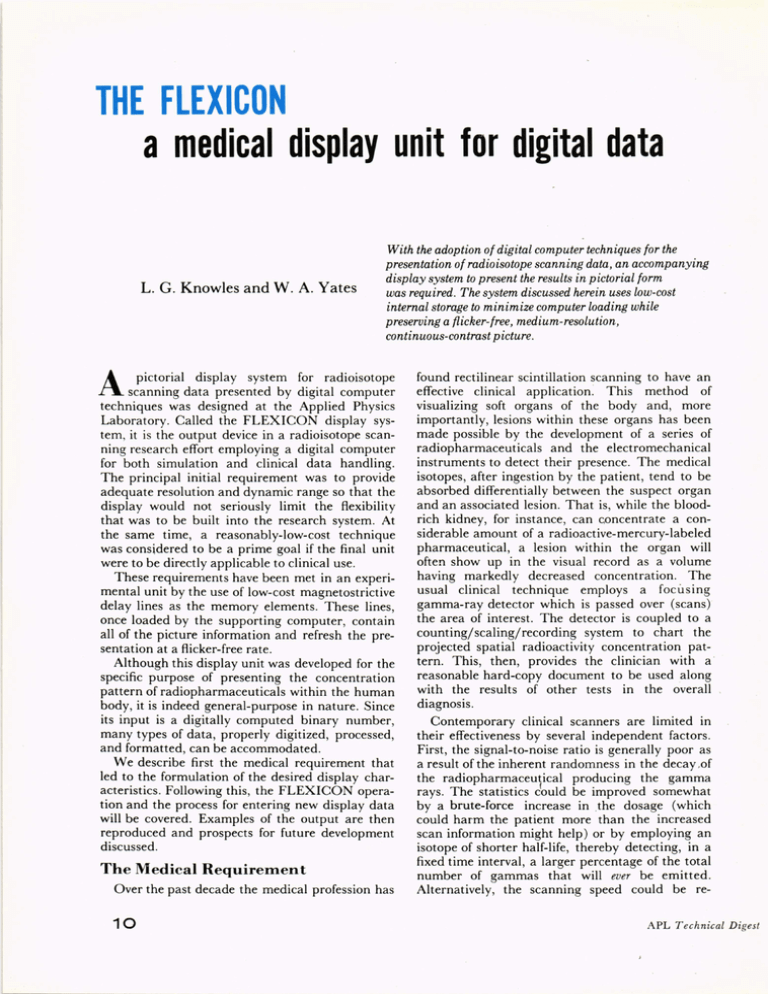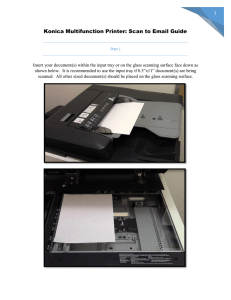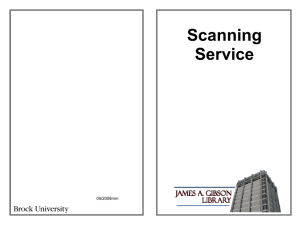THE FLEXICON
advertisement

THE FLEXICON a medical display unit for digital data L. G. Knowles and W. A. Yates With the adoption of digital computer techniques for the presentation of radioisotope scanning data , an accompanying display system to present the results in pictorial form was required. The system discussed herein uses low-cost internal storage to minimize computer loading while preserving a flicker-free, medium-resolution, continuous-contrast picture. A pictorial display system for radioisotope scanning data presented by digital computer techniques was designed at the Applied Physics Laboratory. Called the FLEXICON display system, it is the output device in a radioisotope scanning research effort employing a digital computer for both simulation and clinical data handling. The principal initial requirement was to provide adequate resolution and dynamic range so that the display would not seriously limit the flexibility that was to be built into the research system. At the same time, a reasonably-low-cost technique was considered to be a prime goal if the final unit were to be directly applicable to clinical use. These requirements have been met in an experimental unit by the use of low-cost magnetostrictive delay lines as the memory elements. These lines, once loaded by the supporting computer, contain all of the picture information and refresh the presentation at a flicker-free rate. Although this display unit was developed for the specific purpose of presenting the concentration pattern of radiopharmaceuticals within the human body, it is indeed general-purpose in nature . Since its input is a digitally computed binary number, many types of data, properly digitized, processed, and formatted, can be accommodated. We describe first the medical requirement that led to the formulation of the desired display characteristics. Following this, the FLEXICON operation and the process for entering new display data will be covered. Examples of the output are then reproduced and prospects for future development discussed. The Medical Requirement Over the past decade the medical profession has 10 found rectilinear scintillation scanning to have an effective clinical application: This method of visualizing soft organs of the body and, more importantly, lesions within these organs has been made possible by the development of a series of radiopharmaceuticals and the electromechanical instruments to detect their presence. The medical isotopes, after ingestion by the patient, tend to be absorbed differentially between the suspect organ and an associated lesion. That is, while the bloodrich kidney, for instance, can concentrate a considerable amount of a radioactive-mercury-Iabeled pharmaceutical, a lesion within the organ will often show up in the visual record as a volume having markedly decreased concentration. The usual clinical technique employs a focusing gamma-ray detector which is passed over (scans) the area of interest. The detector is coupled to a counting/ scaling/ recording system to chart the projected spatial radioactivity concentration pattern. This, then, provides the clinician with a ' reasonable hard-copy document to be used along with the results of other tests in the overall diagnosis. Contemporary clinical scanners are limited in their effectiveness by several independent factors. First, the signal-to-noise ratio is generally poor as a result of the inherent randomness in the decay .of the radiopharmaceutical producing the gamma rays. The statistics c10uld be improved somewhat by a brute-force increase in .the dosage (which could harm the patient more than the increased scan information might help) or by employing an isotope of shorter half-life, thereby detecting, in a fixed time interval, a larger percentage of the total number of gammas that will ever be emitted. Alternatively, the scanning speed could be reAPL Technical Digest ~ Il ~ ...... ::. ::: I. GAMMA RADIATION FROM RADIOPHARMACEUTICAL WITHIN PATIENT \ ,1\\ " 1\\\ LEAD COLLIMATOR PULSE AND POSITION DATA SCAN CYCLE PROCESSED PICTURE DIGITIZED PULSE AMPLITUDE. INSTANTANEOUS COUNT RATE PLUS SCAN POSITION PROCESSING OPTION SELECTION l'LEXICON DISPLAY GP DIGITAL COMPUTER SCAN DATA STORAGE DIAGNOSTIC CYCLE Fig. I - Conceptual application of FLEXICON display system in scanning research program. The diagnostic cycle can employ any desired degree of picture processing sophistication without lengthening the patient's scan cycle. duced so that the detector would remain sensitive to each incremental area for a longer period of time. This alternative not only requires that the patient remain quiet that much longer, but, more importantly, reduces the probability of covering the organ of interest during the period of peak isotope concentration. Once a sufficient number of counts has been collected, a second factor-that of a severely limited data-processi ng capability-deprives existing systems of the required flexibility to cope with the very noi ~y data . Along with this limitation is the fact that in most present-day analog systems only one set of processing parameters can be selected per scan. Since the source data are usually lost in the process ing operation, the patient must be given a n additional dose of the radiopharmaceutical and rescanned if the clinician happens to select a set of va riables that produces an unsatisfactory image. To avoid this contingency and make the best use of the available data, the character of each pulse emanating from the gamma-ray detector to be measured is now stored digitally on magnetic tape (Fig. 1). After all of the input data have been collected (a typical scan will require some 15 minutes to complete), that block of data serves as Jan uary - February 1968 the input field to a program within a small-scale general-purpose digital computer. The latter will then provide various data-processing options, under direct operator control, to produce an output field for display. Processing options that are presently considered range from amplitude screening of input field data (to limit the effects of selected gamma energy levels) to spatial frequency filtering of the output field; repeated visualization of the original scan data will guide the observer in making his choices. With the amount of processing to be carried out in the computer, it was considered unwise to impose on it the additional load of display regeneration. Therefore, at the onset , a simple -display technique was sought that would approach television quality, yet would require computer output only when the operator requested a reprocessing. Of the several techniques considered (electronic scan conversion, storage oscillography, etc .), the FLEXICON concept was selected for experimental model development. FLEXICON Operation The heart of the FLEXICON display system (Fig. 2) is the recirculating delay-line memory in 11 11 BIT COMPUTER CHANNEL ~ CURSOR POSITION FEEDBACK ---, ,..- - - - COMPUTER BUFFER I AND PICTURE LOAD I CONTROL I Z r-- tI I~ ~Ig II~w ~I~ u I~ ii:1~ It J: Iii: gl~ 10 I ~ I~ tI tI~ HORIZONTAL ADJACENT ELEMENTS ARE 80 p.sec APART IN TIME ,---'--- 2 MHz CLOCK ,..----------e RASTER SYNCHRONIZATION PICTURE VIDEO • 10 INCHES 160 ELEMENTS VERTICAL ADJACENT RECIRCULATION CLOCKING RECIRCULATING DELAY LINE MEMORY SYSTEM I VERTICAL LINE 80 ~sec TOP TO BOTTOM TIMING FOR COM PUTER LOADING BAS IC TIMING GENERATOR ~I VERTICAL RETRACE RASTER GENERATOR AND OSCILLOSCOPE ~~~ ~ 1-0-_ A_R_E_O_'5_~_se_C APART IN TIME ELEMENT SIZE IS Vi6x Vis______ INCH ___ E_LE_M_E_N_TS __ W ITH INTENSITY ANY ONE OF 64 LEVELS _ __ 250 LINES TOTAL _ _ __ ~~1 --fl l ~------ 15 INCHES-------~ Fig. 2- Basic elements of the FLEX ICON display system. The dashed line connections are active only when the FLEXICON memory is being loaded with a new picture from the supporting computer. Fig.3-Picture generation in the FLEXICON. Note that the high-speed sweep is in the vertical direction and starts at the bottom of the raster; the slower horizontal sweep progresses from left to right. which all of the picture and synchronization data are stored . It consists of seven magnetostrictive delay lines (six for intensity data and the other for synchronization timing) operating in parallel and containing an entire frame of picture data . Each line is recirculated 50 times a second (having a 20-msec delay ) and produces 40,000 picture elements at a 2-MHz bit rate for that frame ; the six-bit data recycling in parallel are converted to 64 levels of video and yield corresponding brightness levels at each picture element. The seventh delay line generates the other output of the memory system-a single clock pulse every 80 J.tsec for synchronizing the high-speed scan, and, after 250 of the latter, a doublet pulse for synchronizing the orthogonal low-speed scan. The resultant raster (Fig. 3) is then composed of 160 by 250 individually controlled picture elements ; it differs from a conventional TV raster in that it has (a) somewhat less definition, (b) the highspeed scan in the vertical direction, and (c) a frame rate of 50 per second without line interlace. To avoid the accumulation of small delay differences between the parallel delay lines in successive circulations , the binary data from each line are reclocked by a common timing gate before being reintroduced in the feedback loop; the clocking gate, in turn, is derived from a highly precise crystal oscillator to which each delay line is adjusted. Delay line stability requirements are set by the necessity to avoid a one bit (0.5 J.tsec) shift out of 20,000 J.tsec over extended periods without readjustment ; this is well within the capabilities of the particular lines selected. To erase the picture data- for example, prior to introduction of new data- all recirculation loops, including the one for sweep synchronization, are momentarily opened, leaving all zeros in the memory system. At the output of the memory system a gated ladder network converts the six bits in intensity data at a 2-MHz rate to a 0 to 10-volt level applied to the cathode ray tube (CRT) intensity grid; a second network separates the doublet pulses from the synchronizing delay line to yield a raster frame sync. The raster generator for CRT deflection consists of two fairly conventional sawtooth waveform generators with the vertical sweep triggered by the synchronizing delay line pulses and the horizontal sweep triggered by the separated doublet circuitry. To allow the display operator the ability to designate to the computer an area on the raster that might be of particular interest to him, a cursor appears on the output display in the form of two orthogonal black lines intersecting at a position determined by the setting of the X and Y position controls. The cursor generator introduces the vertical line as a blanked vertical sweep occurring a controllable number of vertical trigger pulses after the last frame trigger ; this number, selected through a variable-width gate by the operator, is also transmitted to the digital computer. The horizontal cU[$or is produced as a series of short blanked intervals in the vertical sweep; the intervals occur again by counting a number of pulses, this time the 2-MHz clock pulses, from the vertical sweep trigger. Here too, the operator selects the width of the counting gate, and the count number is sent to the computer. 12 Writing a New Picture Loading a new picture into the lines cannot be done in the same straightforward manner in which recirculation of the existing picture is done, APL Technical Digest inhibits recirculation of the eXIstmg data . The reloading of synchronization data, and the formation of the new picture using the dashed circuitry of Fig. 2, begins at the left-hand side of the bottom horizontal row. Advancing to the right, the complete row is written by accepting data words from the computer every 80 Ilsec. Remember that each vertical line is separated in time by that amount (Fig. 3). After 250 elements have been recorded, the next one would be written over the first if the sequence had not been altered. A simple procedure of skipping one clock count (0.5 Ilsec) before allowing the 251 st word to be written enables the first element of the second horizontal row to be entered. The writing process continues with 80 Ilsec between each of the elements in a horizontal row and a similar skip-a-bit routine at the end of each row. A total of 3.2 seconds is required to complete what is essentially a scan conversion process. From then until the picture is to be changed, the display is off-line from the computer. Current Status Fig. 4-Examples of FLEX ICON display: (a) 120 by 80 element picture with 64 levels of intensity; (b) digitallysimulated renal scan with 3/4-in. lesion in left portion and Poisson noise; (c) same as (b) except with lower activity and no noise, processed to truncate intensity levels. because no small general-purpose computer can keep up with the demand for output words at a 2-MHz rate. Although the second-generation model will not be so restricted, the prototype requires that a new picture may be inserted into the delay-line memory only after the existing image has been erased. The erase function simply Januar y - F ebru ary 1968 The present experimental model of the FLEXICON was constructed from components costing about $10,000. It has been in use for several months . Some idea of the fidelity of reproduction may be obtained from the top section of Fig. 4; a photograph was scanned, digitized, recorded on magnetic tape, and subsequently reproduced as shown. The other two sections of Fig. 4 were generated by simulating the radioisotope scanning process using a kidney pattern; two processing variations and the introduction of simulated noise are illustrated. Useful results have already been obtained with the equipment in a series of visual perception tests forming an intial phase of the scanning research effort. It continues to be used in that program and in some detectability studies using spatial filtering as an intermediate process. A second-generation model of FLEXICON is planned, using basically the same operating principle. The circuitry will be packaged somewhat more compactly and will operate more quietly. More importantly, however, it will be capable of about ten times the luminance of the experimental model, permitting operation under more normal room lighting conditions. The authors wish to acknowledge financial support of their work in the form of a grant from the National Institutes of Health, and technical support given by A. G. Schulz, who directs the APL portion of the Scanning. Research program. They also wish to thank L. C . Kohlenstein, T. S. Fisher, and R . F . Mucci for their suggestions and assistance. 13




